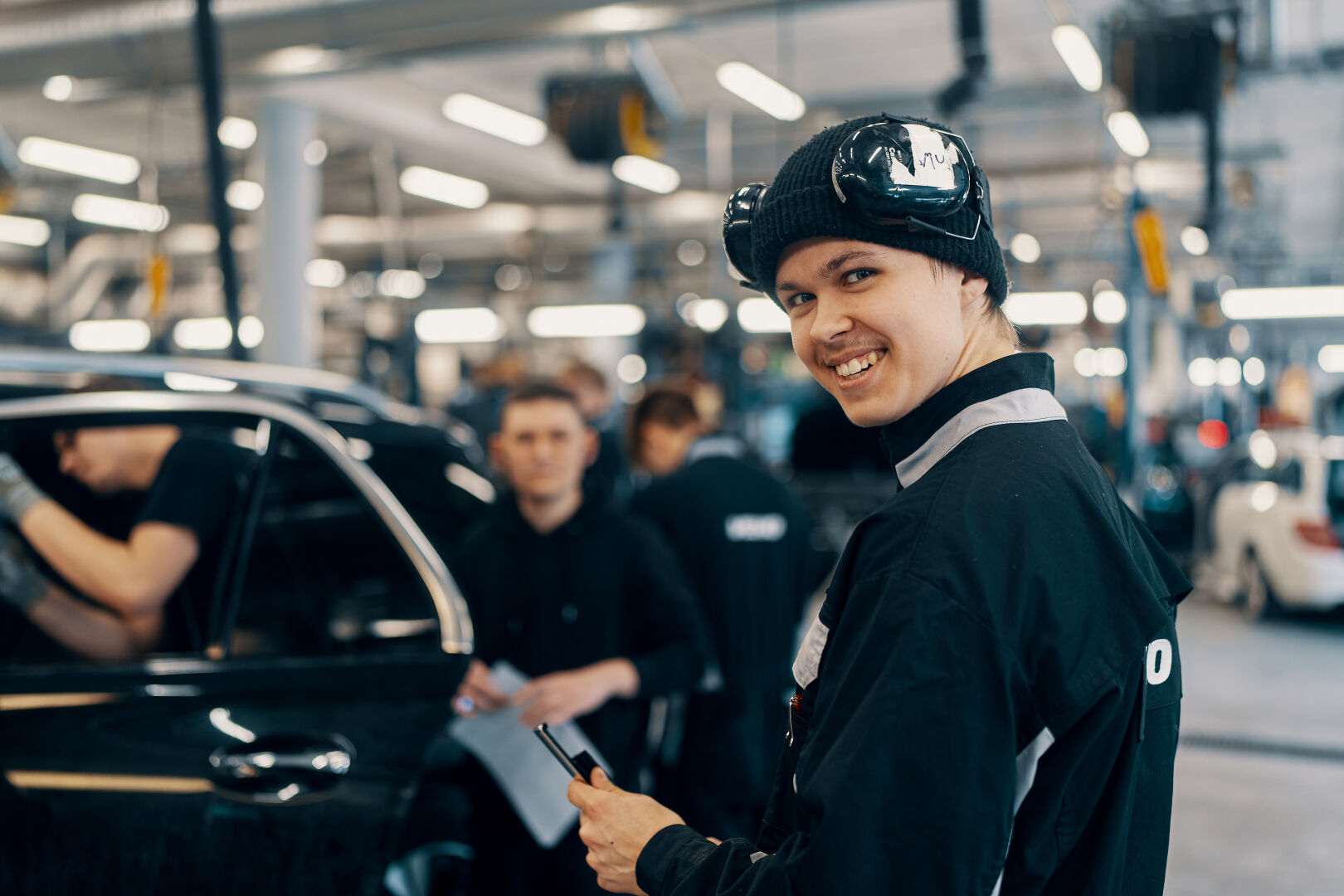

The rapid electrification of the car fleet adds an extra spark to mechanics’ work. There is plenty to learn, and the mechanics at Veho’s Mercedes-Benz service centers regularly get the chance to go back to school.
The training path of Veho mechanics offers the opportunity to train as a Maintenance Technician, System Technician, and Diagnosis Technician, and to qualify for demanding high-voltage work on electric vehicles. The training progresses in stages, allowing mechanics to learn more as they gain experience. Thanks to continuous learning, customers receive five-star service and repairs of both internal combustion engine and electric vehicles – while always prioritizing safety.
When a mechanic joins Veho, they first train to become a Maintenance Technician, regardless of their educational background. A Maintenance Technician, or MT mechanic, focuses on Mercedes-Benz vehicle maintenance and repairs, as well as component changes that do not require in-depth fault diagnosis or mechanical systems expertise. The MT mechanic training includes the first-level requirements for high-voltage work. This means that the mechanic learns to work safely with high-voltage vehicles disconnected from the power supply and knows the first-aid principles related to electrical work.
The next training phase for an MT mechanic is to become a System Technician (or ST mechanic). ST mechanics specialize in certain systems, such as chassis or powertrain systems, and can diagnose and repair related issues. ST mechanics also complete the second and third levels of high-voltage work training, enabling them to safely disconnect components from a high-voltage system. After this, MT mechanics can work safely on electric motors. Most of the work in Veho’s authorized Mercedes-Benz service centers is handled by MT and ST mechanics.

Maintenance Technician Rasmus Nikkinen enjoys his job: “As an MT mechanic, I get to do various maintenance and repair tasks."
After gaining sufficient experience, usually of at least a couple of years, an ST mechanic can choose to continue the path to becoming a Diagnosis Technician (DT mechanic). A DT mechanic often has a supervisory role, performs complex diagnostics and documentation, interacts with customers, and guides other mechanics in their work. DT mechanic training includes the most demanding, fourth-level high-voltage work training. After that, the DT mechanic is qualified to search for and measure faults in high-voltage systems and to act as a technical support person at the workshop in high-voltage matters.
The three-tiered training path for mechanics described above was expanded in the spring of 2024 with the EHV training program (Expert for High-Voltage Systems). The program enables about 50 mechanics in Finland’s service network to become qualified for the most demanding electric vehicle maintenance tasks.
“DT mechanics who have completed all levels of high-voltage training can take EHV training if they wish. This training teaches them, for example, how to open an electric car battery and repair components inside it, avoiding the need for costly battery replacements,” says Jorma Laakkonen, head of Veho’s Training Department.
Veho’s training center is located in Vantaa, where lively chatter fills the workshops and classrooms throughout the year. Approximately 2,500 student workdays are accumulated annually.
Reino Viikilä, who works at the Veho Airport service center, gets frustrated if his job becomes too repetitive. That is why he decided to continue the path from MT to ST mechanic.
“My interest in cars doesn’t end when the workday is over. I also devote myself to road technology and its utilization during my free time. In my work, I want challenges and difficult tasks, and I want to understand concepts such as telematics and networking on a deeper level,” says Viikilä.
The ST mechanic training modules last three days and include a lot of classroom learning – something that Viikilä had to get used to.
“In my job, I’m used to being constantly on the move and working with my hands. Fortunately, the theory sessions are always followed by practical exercises.”
Marko Kuittinen, Service Manager at Veho Airport, is proud that Veho prioritizes continuous learning and that the mechanics are enthusiastic about it.
“We have a very active and self-motivated team. Airport has more ST and DT mechanics per workshop than Mercedes-Benz requires. The competency in high-voltage work is also at a high level, with most of our mechanics already certified for different car models.”
According to Kuittinen, arranging training for employees throughout the year is manageable as part of the service center’s routine, even though coordinating and scheduling training for 60 people might sound daunting. In addition to mechanics, spare parts salespeople and supervisors are also regularly trained.
"The continuous training of mechanics is essential as the vehicle fleet becomes electrified, and Mercedes-Benz's training programs have an excellent scope and quality. We have solid and up-to-date expertise in all mechanics' roles," says Kuittinen.
The benefits of training are also reflected positively in the mechanics’ everyday work.
"The training sessions are a great opportunity for everyone to come together to learn and collaborate. It feels good when I can help a colleague, even in challenging situations," notes Viikilä.
The extensive training path for mechanics allows them to create a personalized career. Anyone can advance to become an EHV mechanic, but for some, MT mechanic work is the most enjoyable, and there is nothing wrong with that.
"All mechanics receive role-specific training annually, regardless of their job description, so no mechanic at Veho is left without continuous training," adds Laakkonen.